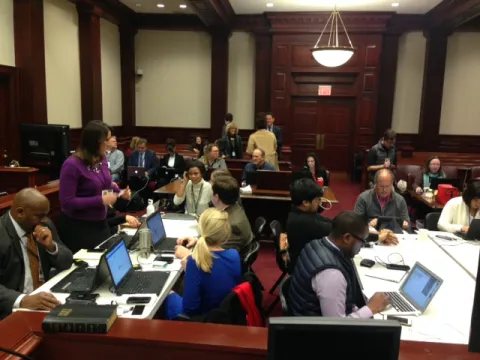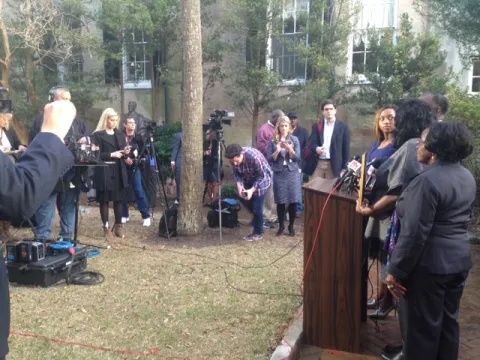On this page
When covering courts, it pays to have a road map. Where can you go? What equipment can you use? Here are some basics.
Federal courts are public institutions, and with rare exceptions, members of the media and public can enter any courthouse and courtroom. However, whether you’re reporting about a high-profile case or the federal courthouse is part of your beat, the Judiciary has distinct differences from the other branches of the federal government, which often affect a reporter’s experience. Here are some notable differences:
- Legal terms. Reporters don’t need a law degree to cover the federal courts, but it is essential to understand and be able to translate legal jargon and procedures for readers or viewers. When in doubt, check the Glossary of Legal Terms.
- Each court is unique. While some rules and statutes govern all federal courts, circuits and districts have substantial autonomy to determine local rules and practices. Understanding the rules will inform your coverage and ease your newsgathering.
- Impartiality. Federal judges adhere to strict ethics guidelines, and recuse themselves from cases that constitute a conflict of interest or in which their impartiality might reasonably be questioned. Cases are assigned to judges randomly in appellate, district, and bankruptcy courts, to ensure fairness and integrity.
- Official proceedings, not interviews. In keeping with ethics rules, federal judges do not grant interviews about active cases. Judges “speak” through comments made in open court or through written decisions. Reporters must rely on the official case proceedings as their primary information source.
Media Access in Brief
Journalists have the same access to courthouses and court records as other members of the public. This access is governed by a mix of federal laws, federal judicial policy, and circuit or district courts’ local rules and practices.
Court documents. Most documents are filed electronically in appellate, district, and bankruptcy courts, and are available through the Public Access to Court Electronic Records service, better known as PACER. PACER documents also can be read at no cost from a public terminal in the clerk's offices. A list of documents not available to the public can be found at Accessing Court Documents.
Interviews. Judges, court staff, and jurors may not discuss active cases. The clerk’s office usually is a court’s designated point of contact with the media.
Courthouse security. Members of the public must pass through a metal detector and agree to any additional requested screening by court security officers to enter a federal courthouse. Some courts permit expedited entry of reporters with recognized credentials. The clerk of court can tell you if this is available.

Courtroom access. Most court proceedings are open to the public on a first come, first served basis. When in doubt, consult with the clerk’s office before a trial or hearing to learn whether there are special media arrangements, such as reserved courtroom seating or a separate media room.
Closed sessions. Certain proceedings are always closed to the public and media. By rule, only a witness, attorneys for the government, and a court reporter may be present when a grand jury sits, and jury deliberations and attorney-client meetings also occur in private. These rules are designed to protect the integrity of the process and preserve the right to a fair and impartial trial. Proceedings that deal with classified information, trade secrets, and ongoing investigations often are closed. Judges also may meet privately with the attorneys in chambers.
Most pretrial hearings are open to the public, but either party may file motions asking the judge to close certain proceedings. Media organizations may choose to file an opposing motion when this occurs.
Off limit areas. Journalists should not cross from the public gallery into the well of the courtroom, which is generally marked by a short rail, without permission from the judge or a court employee. Throughout the courthouse, journalists should obey posted restrictions and instructions from court security officers. Failure to obey courthouse rules may result in sanctions.
Recording and Broadcasting
The use of cameras in federal courtrooms is governed by the Judicial Conference of the United States and Federal Rules of Criminal Procedure. Find the full history of Judiciary policy on cameras.
In specific instances, such as investitures, naturalizations, or other ceremonial proceedings, a judge may permit the public and media to take photographs and conduct video and audio recording inside a courthouse. And by local rule, the Second and Ninth Circuit Courts of Appeals will consider media requests to record or broadcast an appellate proceeding. Guidelines are available at the Second and Ninth Circuit websites.
Outside these limited exceptions, the media may not photograph, videotape or record live federal court proceedings.
Courts of appeals may provide audio or video recordings of appellate hearings, and rules are available on each circuit’s website. The Ninth Circuit website provides live, streaming video of oral arguments.
In addition, three district courts in the Ninth Circuit – the District Court for the Northern District of California, the District Court of Guam, and the District Court for the Western District of Washington – provide court-recorded video of some civil trials. These videos, authorized by Judicial Conference policy, can be seen at Cameras in Courts.
Some district and bankruptcy court proceedings use audio recording instead of a court reporter, and those recordings are available to the public for a fee. A judge also may permit courtroom video and audio recording for security purposes and for other purposes of judicial administration, but these recordings are not available to the public.

It is important to note that the prohibition on recording includes the use of cell phones and other personal electronic devices, even in courthouses where the public is permitted to carry such devices. Journalists must not record or photograph trial-related activity, either in the courtroom or in areas where closed-circuit audio or video is available. Violation of this rule can result in significant court sanctions.
Under local rules, courts may specify areas away from the courtroom where cameras can be used for interviews and TV reports. These areas usually are outside the courthouse, on or just outside federal court property.
Electronic Devices
Circuits and districts set local rules on whether the public and media may bring portable electronic communication devices (such as cell phones, laptops, and tablets) into their courthouses, and where and whether such devices may be used. For guidance on personal electronic devices, consult the local court’s rules or administrative/standing orders on its website, or contact the clerk’s office.
Even if a court generally permits electronic devices, individual judges still may prohibit them inside courtrooms. Judges also may limit the applications that may be used on such devices. For example, even if devices are permitted by court rules, a judge may prohibit live blogging or use of social media applications inside the courtroom.
A Journalist’s Guide to the Federal Courts
- A Journalist’s Guide to the Federal Courts
- Federal Court: Media Basics
- Courthouse Contacts
- Accessing Court Documents
- District Courts
- Reporting on Criminal Cases
- Covering Criminal Trials
- Covering Civil Cases
- Appellate Courts and Cases
- Bankruptcy Courts and Cases
- Judges and Judicial Administration
- Other Judiciary Entities
- Helpful Resources
